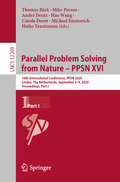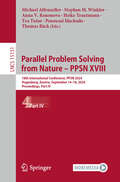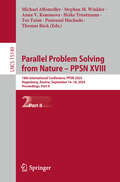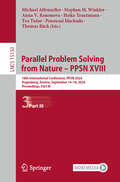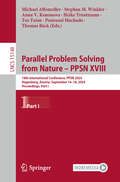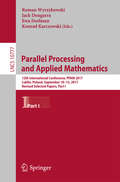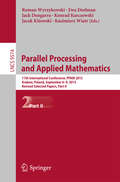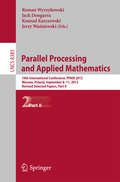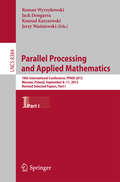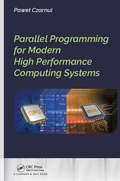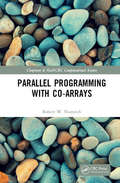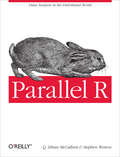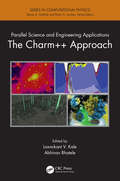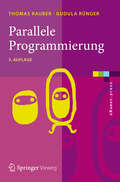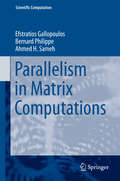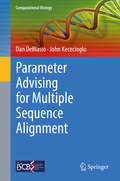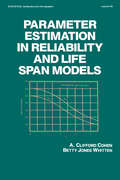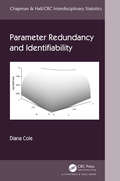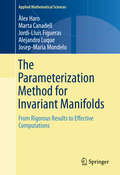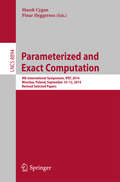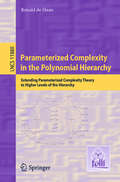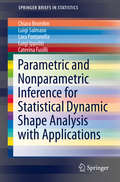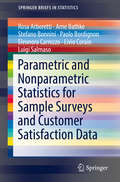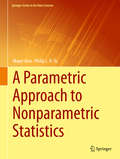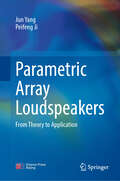- Table View
- List View
Parallel Problem Solving from Nature – PPSN XVI: 16th International Conference, PPSN 2020, Leiden, The Netherlands, September 5-9, 2020, Proceedings, Part I (Lecture Notes in Computer Science #12269)
by Thomas Bäck Mike Preuss André Deutz Hao Wang Carola Doerr Michael Emmerich Heike TrautmannThis two-volume set LNCS 12269 and LNCS 12270 constitutes the refereed proceedings of the 16th International Conference on Parallel Problem Solving from Nature, PPSN 2020, held in Leiden, The Netherlands, in September 2020. The 99 revised full papers were carefully reviewed and selected from 268 submissions. The topics cover classical subjects such as automated algorithm selection and configuration; Bayesian- and surrogate-assisted optimization; benchmarking and performance measures; combinatorial optimization; connection between nature-inspired optimization and artificial intelligence; genetic and evolutionary algorithms; genetic programming; landscape analysis; multiobjective optimization; real-world applications; reinforcement learning; and theoretical aspects of nature-inspired optimization.
Parallel Problem Solving from Nature – PPSN XVIII: 18th International Conference, PPSN 2024, Hagenberg, Austria, September 14–18, 2024, Proceedings, Part IV (Lecture Notes in Computer Science #15151)
by Michael Affenzeller Stephan M. Winkler Anna V. Kononova Heike Trautmann Tea Tušar Penousal Machado Thomas BäckThis multi-volume LNCS set, LNCS 15148-15151, constitutes the refereed proceedings of the 18th International Conference on Parallel Problem Solving from Nature, PPSN 2024, held in Hagenberg, Austria, in September 2024. The 101 full papers presented in these proceedings were carefully reviewed and selected from 294 submissions. The papers presented in these four volumes are organized in the following topical sections: Part I: Combinatorial Optimization; Genetic Programming; Fitness Landscape Modeling and Analysis. Part II: Benchmarking and Performance Measures; Automated Algorithm Selection and Configuration; Numerical Optimization; Bayesian- and Surrogate-Assisted Optimization. Part III: Theoretical Aspects of Nature-Inspired Optimization; (Evolutionary) Machine Learning and Neuroevolution; Evolvable Hardware and Evolutionary Robotics. Part IV: Multi-Objective Optimization; Real-World Applications.
Parallel Problem Solving from Nature – PPSN XVIII: 18th International Conference, PPSN 2024, Hagenberg, Austria, September 14–18, 2024, Proceedings, Part II (Lecture Notes in Computer Science #15149)
by Michael Affenzeller Stephan M. Winkler Anna V. Kononova Heike Trautmann Tea Tušar Penousal Machado Thomas BäckThis multi-volume LNCS set, LNCS 15148-15151, constitutes the refereed proceedings of the 18th International Conference on Parallel Problem Solving from Nature, PPSN 2024, held in Hagenberg, Austria, in September 2024. The 101 full papers presented in these proceedings were carefully reviewed and selected from 294 submissions. The papers presented in these four volumes are organized in the following topical sections: Part I: Combinatorial Optimization; Genetic Programming; Fitness Landscape Modeling and Analysis. Part II: Benchmarking and Performance Measures; Automated Algorithm Selection and Configuration; Numerical Optimization; Bayesian- and Surrogate-Assisted Optimization. Part III: Theoretical Aspects of Nature-Inspired Optimization; (Evolutionary) Machine Learning and Neuroevolution; Evolvable Hardware and Evolutionary Robotics. Part IV: Multi-Objective Optimization; Real-World Applications.
Parallel Problem Solving from Nature – PPSN XVIII: 18th International Conference, PPSN 2024, Hagenberg, Austria, September 14–18, 2024, Proceedings, Part III (Lecture Notes in Computer Science #15150)
by Thomas Bäck Penousal Machado Heike Trautmann Anna V. Kononova Tea Tušar Michael Affenzeller Stephan M. WinklerThis multi-volume LNCS set, LNCS 15148-15151, constitutes the refereed proceedings of the 18th International Conference on Parallel Problem Solving from Nature, PPSN 2024, held in Hagenberg, Austria, in September 2024. The 101 full papers presented in these proceedings were carefully reviewed and selected from 294 submissions. The papers presented in these four volumes are organized in the following topical sections: Part I: Combinatorial Optimization; Genetic Programming; Fitness Landscape Modeling and Analysis. Part II: Benchmarking and Performance Measures; Automated Algorithm Selection and Configuration; Numerical Optimization; Bayesian- and Surrogate-Assisted Optimization. Part III: Theoretical Aspects of Nature-Inspired Optimization; (Evolutionary) Machine Learning and Neuroevolution; Evolvable Hardware and Evolutionary Robotics. Part IV: Multi-Objective Optimization; Real-World Applications.
Parallel Problem Solving from Nature – PPSN XVIII: 18th International Conference, PPSN 2024, Hagenberg, Austria, September 14–18, 2024, Proceedings, Part I (Lecture Notes in Computer Science #15148)
by Thomas Bäck Penousal Machado Heike Trautmann Anna V. Kononova Tea Tušar Michael Affenzeller Stephan M. WinklerThis multi-volume LNCS set, LNCS 15148-15151, constitutes the refereed proceedings of the 18th International Conference on Parallel Problem Solving from Nature, PPSN 2024, held in Hagenberg, Austria, in September 2024. The 101 full papers presented in these proceedings were carefully reviewed and selected from 294 submissions. The papers presented in these four volumes are organized in the following topical sections: Part I: Combinatorial Optimization; Genetic Programming; Fitness Landscape Modeling and Analysis. Part II: Benchmarking and Performance Measures; Automated Algorithm Selection and Configuration; Numerical Optimization; Bayesian- and Surrogate-Assisted Optimization. Part III: Theoretical Aspects of Nature-Inspired Optimization; (Evolutionary) Machine Learning and Neuroevolution; Evolvable Hardware and Evolutionary Robotics. Part IV: Multi-Objective Optimization; Real-World Applications.
Parallel Processing and Applied Mathematics: 4th International Conference, Ppam 2001, Naleczow, Poland, September 9-12, 2001, Revised Papers (Lecture Notes in Computer Science #2328)
by Konrad Karczewski Ewa Deelman Jack Dongarra Roman WyrzykowskiThe two-volume set LNCS 10777 and 10778 constitutes revised selected papers from the 12th International Conference on Parallel Processing and Applied Mathematics, PPAM 2017, held in Lublin, Poland, in September 2017.The 49 regular papers presented in this volume were selected from 98 submissions. For the workshops and special sessions, that were held as integral parts of the PPAM 2017 conference, a total of 51 papers was accepted from 75 submissions. The papers were organized in topical sections named as follows:Part I: numerical algorithms and parallel scientific computing; particle methods in simulations; task-based paradigm of parallel computing; GPU computing; parallel non-numerical algorithms; performance evaluation of parallel algorithms and applications; environments and frameworks for parallel/distributed/cloud computing; applications of parallel computing; soft computing with applications; and special session on parallel matrix factorizations. Part II: workshop on models, algorithms and methodologies for hybrid parallelism in new HPC systems; workshop power and energy aspects of computations (PEAC 2017); workshop on scheduling for parallel computing (SPC 2017); workshop on language-based parallel programming models (WLPP 2017); workshop on PGAS programming; minisymposium on HPC applications in physical sciences; minisymposium on high performance computing interval methods; workshop on complex collective systems.
Parallel Processing and Applied Mathematics
by Kazimierz Wiatr Jacek Kitowski Konrad Karczewski Jack Dongarra Ewa Deelman Roman WyrzykowskiThis two-volume set LNCS 9573 and LNCS 9574 constitutes the refereed proceedings of the 11th International Conference of Parallel Processing and Applied Mathematics, PPAM 2015, held in Krakow, Poland, in September 2015. The 111 revised full papers presented in both volumes were carefully reviewed and selected from 196 submissions. The focus of PPAM 2015 was on models, algorithms, and software tools which facilitate efficient and convenient utilization of modern parallel and distributed computing architectures, as well as on large-scale applications, including big data problems.
Parallel Processing and Applied Mathematics
by Roman Wyrzykowski Jack Dongarra Konrad Karczewski Jerzy WaśniewskiThis two-volume-set (LNCS 8384 and 8385) constitutes the refereed proceedings of the 10th International Conference of Parallel Processing and Applied Mathematics, PPAM 2013, held in Warsaw, Poland, in September 2013. The 143 revised full papers presented in both volumes were carefully reviewed and selected from numerous submissions. The papers cover important fields of parallel/distributed/cloud computing and applied mathematics, such as numerical algorithms and parallel scientific computing; parallel non-numerical algorithms; tools and environments for parallel/distributed/cloud computing; applications of parallel computing; applied mathematics, evolutionary computing and metaheuristics.
Parallel Processing and Applied Mathematics
by Roman Wyrzykowski Jack Dongarra Konrad Karczewski Jerzy WaśniewskiThis two-volume-set (LNCS 8384 and 8385) constitutes the refereed proceedings of the 10th International Conference of Parallel Processing and Applied Mathematics, PPAM 2013, held in Warsaw, Poland, in September 2013. The 143 revised full papers presented in both volumes were carefully reviewed and selected from numerous submissions. The papers cover important fields of parallel/distributed/cloud computing and applied mathematics, such as numerical algorithms and parallel scientific computing; parallel non-numerical algorithms; tools and environments for parallel/distributed/cloud computing; applications of parallel computing; applied mathematics, evolutionary computing and metaheuristics.
Parallel Programming for Modern High Performance Computing Systems
by Pawel CzarnulIn view of the growing presence and popularity of multicore and manycore processors, accelerators, and coprocessors, as well as clusters using such computing devices, the development of efficient parallel applications has become a key challenge to be able to exploit the performance of such systems. This book covers the scope of parallel programming for modern high performance computing systems. It first discusses selected and popular state-of-the-art computing devices and systems available today, These include multicore CPUs, manycore (co)processors, such as Intel Xeon Phi, accelerators, such as GPUs, and clusters, as well as programming models supported on these platforms. It next introduces parallelization through important programming paradigms, such as master-slave, geometric Single Program Multiple Data (SPMD) and divide-and-conquer. The practical and useful elements of the most popular and important APIs for programming parallel HPC systems are discussed, including MPI, OpenMP, Pthreads, CUDA, OpenCL, and OpenACC. It also demonstrates, through selected code listings, how selected APIs can be used to implement important programming paradigms. Furthermore, it shows how the codes can be compiled and executed in a Linux environment. The book also presents hybrid codes that integrate selected APIs for potentially multi-level parallelization and utilization of heterogeneous resources, and it shows how to use modern elements of these APIs. Selected optimization techniques are also included, such as overlapping communication and computations implemented using various APIs. Features: Discusses the popular and currently available computing devices and cluster systems Includes typical paradigms used in parallel programs Explores popular APIs for programming parallel applications Provides code templates that can be used for implementation of paradigms Provides hybrid code examples allowing multi-level parallelization Covers the optimization of parallel programs
Parallel Programming with Co-arrays (Chapman & Hall/CRC Computational Science)
by Robert NumrichParallel Programming with Co-Arrays describes the basic techniques used to design parallel algorithms for high-performance, scientific computing. It is intended for upper-level undergraduate students and graduate students who need to develop parallel codes with little or no previous introduction to parallel computing. It is also intended as a reference manual for researchers active in the field of scientific computing. All the algorithms in the book are based on partition operators. These operators provide a unifying principle that fits seemingly disparate techniques into an overall framework for algorithm design. The book uses the co-array programming model to illustrate how to write code for concrete examples, but it emphasizes that the important concepts for algorithm design are independent of the programming model. With these concepts in mind, the reader can write algorithms in different programming models based on personal taste and comfort.
Parallel R: Data Analysis in the Distributed World
by Q. Ethan McCallum Stephen WestonIt’s tough to argue with R as a high-quality, cross-platform, open source statistical software product—unless you’re in the business of crunching Big Data. This concise book introduces you to several strategies for using R to analyze large datasets, including three chapters on using R and Hadoop together. You’ll learn the basics of Snow, Multicore, Parallel, Segue, RHIPE, and Hadoop Streaming, including how to find them, how to use them, when they work well, and when they don’t.With these packages, you can overcome R’s single-threaded nature by spreading work across multiple CPUs, or offloading work to multiple machines to address R’s memory barrier.Snow: works well in a traditional cluster environmentMulticore: popular for multiprocessor and multicore computersParallel: part of the upcoming R 2.14.0 releaseR+Hadoop: provides low-level access to a popular form of cluster computingRHIPE: uses Hadoop’s power with R’s language and interactive shellSegue: lets you use Elastic MapReduce as a backend for lapply-style operations
Parallel Science and Engineering Applications: The Charm++ Approach
by Laxmikant V. Kale Abhinav BhateleDeveloped in the context of science and engineering applications, with each abstraction motivated by and further honed by specific application needs, Charm++ is a production-quality system that runs on almost all parallel computers available. Parallel Science and Engineering Applications: The Charm++ Approach surveys a diverse and scalable collecti
Parallele Programmierung
by Gudula Rünger Thomas RauberMultiprozessor-Desktoprechner, Cluster von PCs und Innovationen wie Hyperthreading oder Multicore-Prozessoren machen parallele Rechenressourcen allgegenwärtig. Die Ausnutzung dieser Rechenleistung ist jedoch nur durch parallele Programmiertechniken möglich. Das Buch stellt diese Techniken für herkömmliche Parallelrechner und für neuartige Plattformen umfassend dar. Neben den Grundlagen der parallelen Programmierung werden Programmierumgebungen wie Pthreads, Java-Threads, OpenMP, MPI oder PVM sowie die zugehörigen Programmiermodelle behandelt.
Parallelism in Matrix Computations
by Efstratios Gallopoulos Bernard Philippe Ahmed H. SamehThis book is primarily intended as a research monograph that could also be used in graduate courses for the design of parallel algorithms in matrix computations. It assumes general but not extensive knowledge of numerical linear algebra, parallel architectures, and parallel programming paradigms. The book consists of four parts: (I) Basics; (II) Dense and Special Matrix Computations; (III) Sparse Matrix Computations; and (IV) Matrix functions and characteristics. Part I deals with parallel programming paradigms and fundamental kernels, including reordering schemes for sparse matrices. Part II is devoted to dense matrix computations such as parallel algorithms for solving linear systems, linear least squares, the symmetric algebraic eigenvalue problem, and the singular-value decomposition. It also deals with the development of parallel algorithms for special linear systems such as banded ,Vandermonde ,Toeplitz ,and block Toeplitz systems. Part III addresses sparse matrix computations: (a) the development of parallel iterative linear system solvers with emphasis on scalable preconditioners, (b) parallel schemes for obtaining a few of the extreme eigenpairs or those contained in a given interval in the spectrum of a standard or generalized symmetric eigenvalue problem, and (c) parallel methods for computing a few of the extreme singular triplets. Part IV focuses on the development of parallel algorithms for matrix functions and special characteristics such as the matrix pseudospectrum and the determinant. The book also reviews the theoretical and practical background necessary when designing these algorithms and includes an extensive bibliography that will be useful to researchers and students alike. The book brings together many existing algorithms for the fundamental matrix computations that have a proven track record of efficient implementation in terms of data locality and data transfer on state-of-the-art systems, as well as several algorithms that are presented for the first time, focusing on the opportunities for parallelism and algorithm robustness.
Parameter Advising for Multiple Sequence Alignment
by Dan DeBlasio John KececiogluThis book develops a new approach called parameter advising for finding a parameter setting for a sequence aligner that yields a quality alignment of a given set of input sequences. In this framework, a parameter advisor is a procedure that automatically chooses a parameter setting for the input, and has two main ingredients: (a) the set of parameter choices considered by the advisor, and (b) an estimator of alignment accuracy used to rank alignments produced by the aligner. On coupling a parameter advisor with an aligner, once the advisor is trained in a learning phase, the user simply inputs sequences to align, and receives an output alignment from the aligner, where the advisor has automatically selected the parameter setting. The chapters first lay out the foundations of parameter advising, and then cover applications and extensions of advising. The content * examines formulations of parameter advising and their computational complexity, * develops methods for learning good accuracy estimators, * presents approximation algorithms for finding good sets of parameter choices, and * assesses software implementations of advising that perform well on real biological data. Also explored are applications of parameter advising to * adaptive local realignment, where advising is performed on local regions of the sequences to automatically adapt to varying mutation rates, and * ensemble alignment, where advising is applied to an ensemble of aligners to effectively yield a new aligner of higher quality than the individual aligners in the ensemble. The book concludes by offering future directions in advising research.
Parameter Estimation in Reliability and Life Span Models
by A Clifford Cohen Betty Jones WhittenOffers an applications-oriented treatment of parameter estimation from both complete and censored samples; contains notations, simplified formats for estimates, graphical techniques, and numerous tables and charts allowing users to calculate estimates and analyze sample data quickly and easily. Anno
Parameter Redundancy and Identifiability (Chapman & Hall/CRC Interdisciplinary Statistics)
by Diana ColeStatistical and mathematical models are defined by parameters that describe different characteristics of those models. Ideally it would be possible to find parameter estimates for every parameter in that model, but, in some cases, this is not possible. For example, two parameters that only ever appear in the model as a product could not be estimated individually; only the product can be estimated. Such a model is said to be parameter redundant, or the parameters are described as non-identifiable. This book explains why parameter redundancy and non-identifiability is a problem and the different methods that can be used for detection, including in a Bayesian context. Key features of this book: Detailed discussion of the problems caused by parameter redundancy and non-identifiability Explanation of the different general methods for detecting parameter redundancy and non-identifiability, including symbolic algebra and numerical methods Chapter on Bayesian identifiability Throughout illustrative examples are used to clearly demonstrate each problem and method. Maple and R code are available for these examples More in-depth focus on the areas of discrete and continuous state-space models and ecological statistics, including methods that have been specifically developed for each of these areas This book is designed to make parameter redundancy and non-identifiability accessible and understandable to a wide audience from masters and PhD students to researchers, from mathematicians and statisticians to practitioners using mathematical or statistical models.
The Parameterization Method for Invariant Manifolds
by Àlex Haro Marta Canadell Jordi-Lluis Figueras Alejandro Luque Josep Maria MondeloThismonograph presents some theoretical and computational aspects of theparameterization method for invariant manifolds, focusing on the followingcontexts: invariant manifolds associated with fixed points, invariant tori inquasi-periodically forced systems, invariant tori in Hamiltonian systems andnormally hyperbolic invariant manifolds. This book provides algorithms ofcomputation and some practical details of their implementation. The methodologyis illustrated with 12 detailed examples, many of them well known in theliterature of numerical computation in dynamical systems. A public version of the software used for some of the examples is available online. Thebook is aimed at mathematicians, scientists and engineers interested in thetheory and applications of computational dynamical systems.
Parameterized and Exact Computation
by Marek Cygan Pinar HeggernesThis book constitutes the thoroughly refereed post-conference proceedings of the 9th International Symposium on Parameterized and Exact Computation, IPEC 2014, in Wroclaw, Poland, in September 2014. The 27 revised full papers presented together with one invited paper were carefully reviewed and selected from 42 submissions. The topics addressed cover research in all aspects of parameterized/exact algorithms and complexity including but are not limited to new techniques for the design and analysis of parameterized and exact algorithms, fixed-parameter tractability results; parameterized complexity theory, relationship between parameterized complexity and traditional complexity classifications; applications of parameterized and exact exponential-time computation; and implementation issues of parameterized and exact exponential-time algorithms.
Parameterized Complexity in the Polynomial Hierarchy: Extending Parameterized Complexity Theory to Higher Levels of the Hierarchy (Lecture Notes in Computer Science #11880)
by Ronald de HaanParameterized Complexity in the Polynomial Hierarchy was co-recipient of the E.W. Beth Dissertation Prize 2017 for outstanding dissertations in the fields of logic, language, and information. This work extends the theory of parameterized complexity to higher levels of the Polynomial Hierarchy (PH). For problems at higher levels of the PH, a promising solving approach is to develop fixed-parameter tractable reductions to SAT, and to subsequently use a SAT solving algorithm to solve the problem. In this dissertation, a theoretical toolbox is developed that can be used to classify in which cases this is possible. The use of this toolbox is illustrated by applying it to analyze a wide range of problems from various areas of computer science and artificial intelligence.
Parametric and Nonparametric Inference for Statistical Dynamic Shape Analysis with Applications
by Chiara Brombin Luigi Salmaso Lara Fontanella Luigi Ippoliti Caterina FusilliThis book considers specific inferential issues arising from the analysis of dynamic shapes with the attempt to solve the problems at hand using probability models and nonparametric tests. The models are simple to understand and interpret and provide a useful tool to describe the global dynamics of the landmark configurations. However, because of the non-Euclidean nature of shape spaces, distributions in shape spaces are not straightforward to obtain. The book explores the use of the Gaussian distribution in the configuration space, with similarity transformations integrated out. Specifically, it works with the offset-normal shape distribution as a probability model for statistical inference on a sample of a temporal sequence of landmark configurations. This enables inference for Gaussian processes from configurations onto the shape space. The book is divided in two parts, with the first three chapters covering material on the offset-normal shape distribution, and the remaining chapters covering the theory of NonParametric Combination (NPC) tests. The chapters offer a collection of applications which are bound together by the theme of this book. They refer to the analysis of data from the FG-NET (Face and Gesture Recognition Research Network) database with facial expressions. For these data, it may be desirable to provide a description of the dynamics of the expressions, or testing whether there is a difference between the dynamics of two facial expressions or testing which of the landmarks are more informative in explaining the pattern of an expression.
Parametric and Nonparametric Statistics for Sample Surveys and Customer Satisfaction Data (SpringerBriefs in Statistics)
by Rosa Arboretti Arne Bathke Stefano Bonnini Paolo Bordignon Eleonora Carrozzo Livio Corain Luigi SalmasoThis book deals with problems related to the evaluation of customer satisfaction in very different contexts and ways. Often satisfaction about a product or service is investigated through suitable surveys which try to capture the satisfaction about several partial aspects which characterize the perceived quality of that product or service. This book presents a series of statistical techniques adopted to analyze data from real situations where customer satisfaction surveys were performed.The aim is to give a simple guide of the variety of analysis that can be performed when analyzing data from sample surveys: starting from latent variable models to heterogeneity in satisfaction and also introducing some testing methods for comparing different customers. The book also discusses the construction of composite indicators including different benchmarks of satisfaction. Finally, some rank-based procedures for analyzing survey data are also shown.
A Parametric Approach to Nonparametric Statistics (Springer Series in the Data Sciences)
by Philip L. H. Yu Mayer AlvoThis book demonstrates that nonparametric statistics can be taught from a parametric point of view. As a result, one can exploit various parametric tools such as the use of the likelihood function, penalized likelihood and score functions to not only derive well-known tests but to also go beyond and make use of Bayesian methods to analyze ranking data. The book bridges the gap between parametric and nonparametric statistics and presents the best practices of the former while enjoying the robustness properties of the latter. This book can be used in a graduate course in nonparametrics, with parts being accessible to senior undergraduates. In addition, the book will be of wide interest to statisticians and researchers in applied fields.
Parametric Array Loudspeakers: From Theory to Application
by Jun Yang Peifeng JiThis book highlights a comprehensive overview of research and technical advances related to parametric array loudspeakers (PALs), covering modeling and simulation, measurements, signal processing, beamsteering, and their implementations and applications. PALs that can achieve directional sound reproduction have received widespread attention from global researchers due to their advantages of narrow beam, highly directivity, and very small sidelobes. PALs have developed rapidly in theory and application and have been used in various commercial products. At present, PALs have become a research hotspot in the field of audio engineering. The book is a must-have guiding reference for researchers, professionals and graduate students who seek to conduct further research on PALs.
